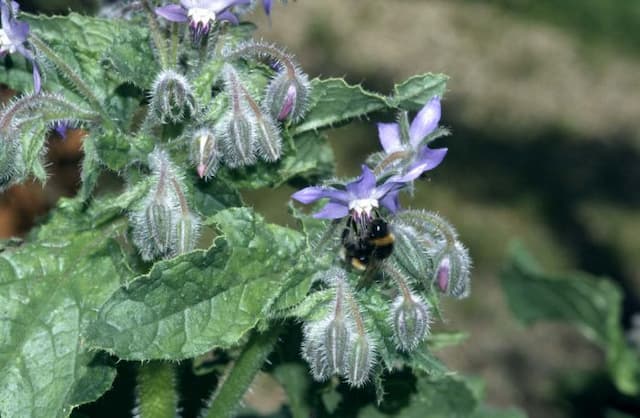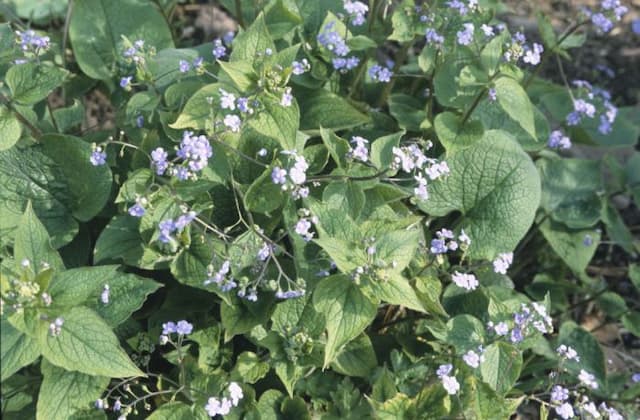Forget-me-not Myosotis scorpioides

ABOUT
Myosotis scorpioides, commonly known as the water forget-me-not, is a herbaceous perennial plant that features a basal rosette of leaves from which stems emerge. The leaves are generally lance-shaped to oblong, smooth along the edges, and attached to the stem by a short petiole or directly by their bases in a sessile manner. They are typically green, sometimes with a hint of grayish or bluish tones, and have a somewhat fleshy texture. The water forget-me-not blooms profusely with tiny flowers that are most often bright sky blue in color, though they can sometimes exhibit shades of pink or white. Each five-petaled flower possesses a yellow to white central eye, which serves to attract pollinators. The petals are arranged in a star-like pattern around the center. Flowers are borne in clusters on coiled, cyme-like inflorescences that uncoil as the flowers mature, giving the impression of a scorpion's tail, which is reflected in the species name 'scorpioides'. This unique flowering pattern contributes to the plant's overall visual interest. The water forget-me-not typically favors moist environments and can often be found along the edges of streams, ponds, and wetlands, where it forms lush mats of vegetation that are attractive to various pollinators, such as bees and butterflies. The preference for such habitats is also mirrored in the common name, emphasizing its affinity for wet conditions. Its display of delicate blooms above the green foliage makes it a favored choice for gardeners looking to add a touch of color to water features or damp garden spots.
About this plant
 Names
NamesFamily
Boraginaceae.
Synonyms
Water Forget-Me-Not, True Forget-Me-Not, Marsh Forget-Me-Not, Scorpion Grass, Love-Me, Mouse Ear.
Common names
Myosotis palustris, Myosotis scorpioides var. caespitosa, Myosotis scorpioides var. semiterrestris, Myosotis scorpioides subsp. caespitosa, Myosotis caespititicia, Myosotis limosa, Myosotis scorpioides f. caespitosa, Myosotis scorpioides subsp. scorpioides, Myosotis palustris var. caespitosa, Myosotis palustris var. semiterrestris.
 Toxicity
ToxicityTo humans
The plant known as Forget-Me-Not (Myosotis scorpioides) is generally considered non-toxic to humans. There are no well-documented cases of poisoning from ingesting parts of this plant. However, it is always advisable to exercise caution and avoid consuming any part of ornamental plants as their effects can vary among individuals, and some may experience allergic reactions or stomach upset.
To pets
The Forget-Me-Not (Myosotis scorpioides) is not listed as a toxic plant for pets either. While it is not known to be poisonous, it is still recommended to prevent pets from ingesting plants as they can cause gastrointestinal upset or an allergic reaction in some animals. If a pet shows any signs of distress after ingesting this plant, it is advisable to consult a veterinarian.
 Characteristics
CharacteristicsLife cycle
Perennials
Foliage type
Deciduous
Color of leaves
Green
Flower color
Blue
Height
1 foot (30 centimeters)
Spread
1 foot (30 centimeters)
Plant type
Herb
Hardiness zones
5
Native area
Europe
Benefits
 General Benefits
General Benefits- Ornamental Value: Myosotis scorpioides, commonly known as water forget-me-not, adds aesthetic appeal to garden ponds and water features with its bright blue flowers.
- Wildlife Habitat: It provides a habitat and nesting sites for some aquatic insects and offers shelter to amphibians such as frogs.
- Pollinator Attraction: The flowers attract various pollinators, including bees and butterflies, which are essential for the pollination of other plants.
- Soil Erosion Control: Its root system helps stabilize soil around water bodies, reducing erosion and improving water quality.
- Water Edge Beautification: It can naturalize at the edges of streams and ponds, enhancing the transition between the water and land.
 Medical Properties
Medical Properties- Anti-inflammatory: Myosotis scorpioides, commonly known as water forget-me-not, has been traditionally used for its supposed anti-inflammatory properties.
- Astringent: The plant is sometimes considered to have astringent qualities, which might help in tightening the skin and reducing secretions.
 Air-purifying Qualities
Air-purifying QualitiesThis plant is not specifically known for air purifying qualities.
 Other Uses
Other Uses- As a natural dye: Myosotis scorpioides can be used to produce a blue dye for fabrics, given its blue-colored flowers.
- Garden aesthetics: The plant is often used in gardens for its aesthetic value, especially in rock gardens and along pond edges due to its beautiful blue flowers and preference for moist conditions.
- Erosion control: This plant can help stabilize soil in wetland areas and riverbanks, preventing erosion with its root system.
- As a food source for wildlife: The nectar and pollen of the Myosotis scorpioides attract bees, butterflies, and some beetles, which can aid in promoting biodiversity in a garden setting.
- Indicator species: Its presence can indicate a healthy, wet ecosystem, which can be useful in ecological assessments and monitoring.
- Companion planting: It can be planted alongside other water-loving plants to create a diverse and supportive wetland plant community.
- Photography and art: The striking blue flowers of Myosotis scorpioides make it a popular subject for photographers and artists wanting to capture the beauty of natural flora.
- Floral arrangements: Fresh or dried, the tiny blue flowers are used in floral arrangements and bouquets for a delicate appearance and symbolize loyalty and remembrance.
- Educational tool: Myosotis scorpioides can be used in educational settings such as schools and nature centers to teach about plant life cycles and wetland ecosystems.
- Memory gardens: As Forget-me-nots are symbols of memory and remembrance, they are often planted in memory gardens or used in commemorative contexts.
Interesting Facts
 Feng Shui
Feng ShuiForget-me-not is not used in Feng Shui practice.
 Zodiac Sign Compitability
Zodiac Sign CompitabilityForget-me-not is not used in astrology practice.
 Plant Symbolism
Plant Symbolism- True Love: Myosotis scorpioides, commonly known as the Forget-Me-Not, is a symbol for true love, as it is often used to represent deep and enduring romantic feelings that withstand time and distance.
- Remembrance: As its common name suggests, Forget-Me-Nots are a traditional symbol of remembrance. They are often given or worn to remember someone who is absent or has passed away.
- Memory: The Forget-Me-Not carries with it the meaning of memory and is commonly associated with cherished memories of loved ones or significant life events.
- Faithful Love: The plant is also indicative of faithful love and fidelity. Sharing Forget-Me-Nots can be a message of steadfastness and unwavering devotion in a relationship.
- Connection: Forget-Me-Nots represent a connection that endures all challenges, symbolizing that the giver and the receiver will always stay connected in their thoughts.
 Water
WaterThe Forget-Me-Not, commonly known as Myosotis scorpioides, thrives in consistently moist soil and requires regular watering to maintain this moisture level. It is recommended to water the plant thoroughly, ensuring water penetrates the soil to reach the roots, approximately one to two times a week, depending on weather conditions. During periods of high heat or drought, watering frequency may increase to every other day to prevent the soil from drying out. A rough guideline for watering amounts is to provide about one gallon of water per square foot every week. Avoid overhead watering to reduce the risk of leaf diseases, and instead focus on watering at the soil level.
 Light
LightForget-Me-Not plants prefer partial shade to full sun, ideally receiving morning sunlight and afternoon shade to protect them from the scorching midday heat. A spot that gets filtered sunlight throughout the day or direct sun only in the cooler parts of the day is optimal. Avoid placing them in deep shade, as this can result in poor flowering and weak growth.
 Temperature
TemperatureForget-Me-Nots are hardy and can withstand a range of temperatures but grow best in cooler conditions with ideal temperatures between 60°F and 70°F. They can survive minimum temperatures down to around 40°F but should be protected from frosts and extreme cold. These plants often struggle in high heat, especially when temperatures exceed 80°F, so providing afternoon shade during hot spells can help maintain the ideal growing conditions.
 Pruning
PruningPruning Forget-Me-Nots involves the removal of spent flowers and dead foliage to encourage a second bloom and to maintain plant health. Pinch or cut back the stems after the first flush of flowers has faded to promote bushier growth and potential additional blooms. Pruning is best done in late spring or early summer after the initial flowering period, and any dead or yellowing leaves should be removed as needed to keep the plant looking tidy.
 Cleaning
CleaningAs needed
 Soil
SoilThe Forget-me-not (Myosotis scorpioides) thrives best in moist, well-draining soil with a rich organic content, aiming for a slightly acidic to neutral pH of 6.0 to 7.0. A soil mix of peat, loam, and sand in equal parts can provide the desired texture and nutrients.
 Repotting
RepottingForget-me-nots (Myosotis scorpioides) do not typically require frequent repotting and can often be left undisturbed for several years. They may only need repotting if the clumps become too crowded or if they have outgrown their container.
 Humidity & Misting
Humidity & MistingForget-me-nots (Myosotis scorpioides) prefer high humidity levels, thriving best in environments that mimic their natural damp, riverside habitat. They can tolerate average room humidity but flourish when the air is more moist.
 Suitable locations
Suitable locationsIndoor
Place in bright, indirect light; maintain high humidity.
Outdoor
Choose moist, semi-shaded areas; protect from afternoon sun.
Hardiness zone
3-8 USDA
 Life cycle
Life cycleMyosotis scorpioides, commonly known as water forget-me-not, begins its life cycle with seed germination, which occurs in moist or aquatic environments typically in the spring. The seeds develop into small rosettes of leaves at the water's edge, which then grow into mature flowering plants with a height of about 10 to 30 cm. During its flowering stage in late spring to autumn, water forget-me-not produces small, blue with yellow center flowers that are pollinated by insects such as bees and butterflies. After pollination, the flowers develop into small, four-lobed fruits containing seeds that are dispersed by water or animals, completing the reproductive cycle. In the winter or in adverse conditions, the plant may undergo dormancy, surviving as seeds or sometimes as vegetative parts before resuming growth in the next favorable season. Water forget-me-nots can also reproduce vegetatively through stoloniferous growth, where stems grow horizontally on or just below the surface and root at nodes to form new plants.
 Propogation
PropogationPropogation time
Spring-Early Summer
Propogation: The Forget-me-not (Myosotis scorpioides) is often propagated through seed sowing. The optimal time for sowing Forget-me-not seeds directly into the ground is in the fall or spring. To propagate, spread the small seeds over the surface of prepared soil in a flower bed or pot. Lightly press the seeds into the moist soil but do not cover them, as they need light to germinate. Keep the soil consistently moist until germination, which typically occurs in 14 to 21 days. Thin the seedlings as they grow to prevent overcrowding and ensure the healthiest plants have room to mature.








